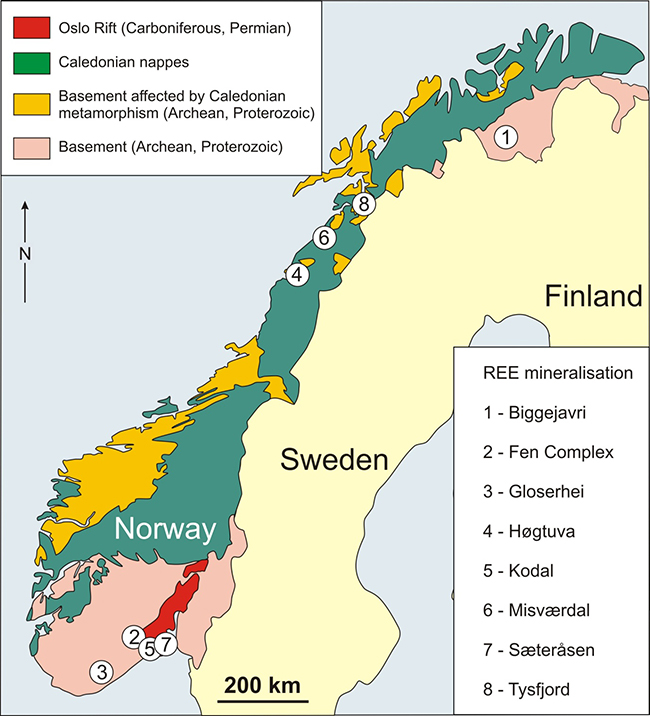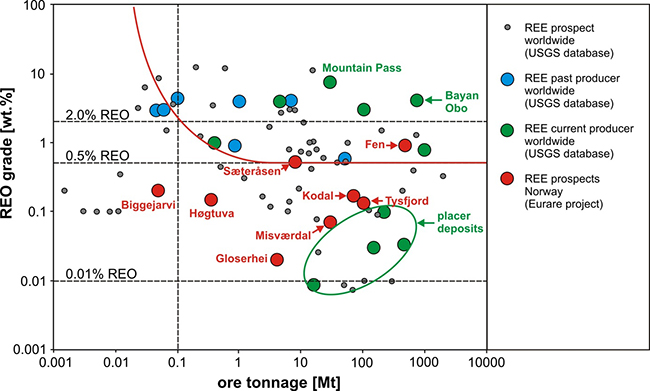REE mineralisation in Norway
Norway, as part of the Fennoscandian shield, is considered as an area of high potential for metal exploration in Europe, including the REE. The present knowledge of Norwegian REE deposits is primarily based on data collected during exploration and exploitation for uranium (U), beryllium (Be) and niobium (Nb) mineralisation and from the quarrying of quartz and feldspar in pegmatites. REE mineralisation in Norway includes examples related to magmatic and to hydrothermal-metasomatic processes.
REE mineralisation types in Norway
Genetically, Norwegian REE mineralisation can be classified into six types. All these types are considered as primary deposits. The six types include:
- REE associated with apatite iron oxide ores (Kodal). Norwegian apatite-rich iron oxide mineralisation is related to the Permian pyroxenites of the Oslo graben, which are part of monzonitic plutonic complexes. Apatite in the pyroxenites contains >6000 parts per million (ppm) total REE.
- REE-enriched alkaline to peralkaline monzonitic/syenitic complexes (Sæteråsen, Misværdalen). Alkaline to peralkaline complexes in the Palaeozoic Oslo graben are generally enriched in REE and Nb, thorium (Th) and/or zirconium (Zr). In the Sæteråsen deposit, fine-grained disseminations of complex REE-Nb-Th silicates and oxides occur in trachytic lava. The potential for finding similar deposits within the Vestfold lava plateau is good. Another example is the Silurian Misværdal alkaline-ultrapotassic complex where REE-bearing apatite constitutes up to 10 wt per cent in pyroxenite.
- REE within carbonatite complexes (Fen). The Fen complex carbonatite south west of Oslo carries low-grade Nb ores and REE- and Th-enriched iron oxide ores, which were mined in the past. It is the deposit with the highest economic potential for REE in Norway, but the depth extension of the mineralization is poorly known.
- Hydrothermal-metasomatic REE deposits (Biggejavri). Metasomatic albitites with U-REE mineralisation occur in the Palaeoproterozoic Kautokeino greenstone belt.
- REE-enriched pegmatites (Gloserhei). Rare metal pegmatites with accessory REE-, Nb-, tantalum (Ta)-, Be-, Th- and/or U-bearing minerals occur in the Sveconorwegian orogenic belt in south Norway and in Proterozoic granites in north Norway.
- REE-enriched granites (Høgtuva, Tysfjord). Highly-fractionated Palaeoproterozoic granitic orthogneisses in basement windows in the Caledonides show local enrichments in allanite, light REE-bearing titanite, and fluorite. The Høgtuva Be deposit is also enriched in REE, U and Zr.
REE exploitation
The possible exploitation of any of these occurrences is dependent on the market as well as on grade and tonnage. Mineralogy is another crucial geological factor in this respect, both the grain size and the mineral constituents themselves. The more easily extractable REE-bearing minerals, such as the carbonate bastnäsite and the phosphates monazite and xenotime, are preferred to the less soluble oxides and silicates with current technology. For a number of the Norwegian localities the production of by-products has to be considered in order to increase the economic value. This is the case for Be and Zr at Høgtuva, scandium (Sc) at Biggejavri and Nb at Fen and Sæteråsen. The REE market is growing, but technological challenges exist regarding the possible exploitation of any of the Norwegian REE resources.
| Deposit name |
Geological district | REE deposit type | Major REE minerals | Host rock | Age (Ga) | Resources (mill tons) |
REO (tons) |
REO grade (wt.%) | |
|---|---|---|---|---|---|---|---|---|---|
| 1 | Biggejavri | Kautokeino greenstone belt | Hydrothermal/ metasomatic |
Davidite, xenotime, monazite | Albitite | 1.76 | 0.05 | 100 | 0.20 |
| 2 | Fen | Telemark block | Carbonatite | Bastnäsite, parisite, monazite | Søvite | 0.58 | 486? | 4.4 mill? | 0.90? |
| 3 | Gloserhei | Bamble block | Pegmatitic | Allanite | Pegmatite | 1.06 | 4 | 800? | 0.02? |
| 4 | Høgtuva | Trans-Scandinavian igneous belt | Granitic | Zircon, allanite, gadolinite | Granitic gneiss | 1.80 | 0.35 | 525 | 0.15 |
| 5 | Kodal | Oslo graben | Iron REE | Apatite | Pyroxenite | 0.29 | 70 | 120 000 | 0.17 |
| 6 | Misværdalen | Caledonides | Alkaline igneous-associated | Apatite | Pyroxenite | 0.44 | 30 | 21 000 | 0.07 |
| 7 | Sæteråsen | Oslo graben | Alkaline igneous-associated | Euxenite, pyrochlore, apatite | Aphyric trachyte | 0.29 | 8 | 41 600 | 0.52 |
| 8 | Tysfjord | Trans-Scandinavian igneous belt | Granitic | Zircon, allanite, titanite | Granitic gneiss | 1.80 | >100 | >130 000 | 0.13 |
Key references
Åmli, R. 1975. Mineralogy and rare earth geochemistry of apatite and xenotime from the Gloserheia granite pegmatite, Froland, southern Norway. American Mineralogist, 60:607–620.
Ihlen, P M, Schiellerup, H, Gautneb, H, and Skår, Ø. 2014. Characterization of apatite resources in Norway and their REE potential — A review. Ore Geology Reviews, 58: 126–147.
Müller, A. 2010. Potential for rare earth element and Zr-, Be-, U-, Th-, (W-)mineralisations in central and northern Nordland. Norges Geologiske Undersøkelse Report No. 2009.037.
Schilling, J. 2013. Petrography, mineralogy and whole-rock data of the major lithologies of the Fen Complex. Norges Geologiske Undersøkelse Report No. 2013.034.



